Featured This Month
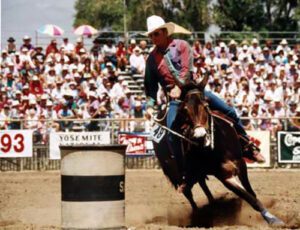
MULE CROSSING: Surge of Mule Shows
All Articles
MULE CROSSING: Leverage Versus Abuse
By Meredith Hodges
“Leverage” equipment refers to any restraining device or substance that is used to get an equine’s attention and obtain compliance, but many leverage practices often have the reverse effect and have the potential to cause 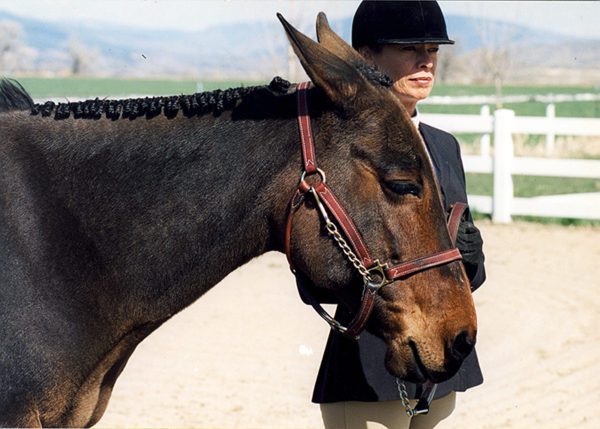 distress and pain. This includes harsh bits, chain leads, twitches, hobbles, stocks and even medications. There are times when our equines can really be a handful, so having a little leverage when needed can be a good thing. However, deciding which equipment to use and learning how to use leverage without it becoming abusive can be a bit daunting. There are so many different types of tack, equipment and restraints that it becomes difficult to determine which would be best to use on your equine to correct a particular problem, or if you really need to use anything at all. It may only be a case of needing to be clearer in your approach, in which case, leverage equipment may not be needed. It is important to make an informed decision when using any leverage equipment to be sure that what you are using is helpful and not abusive.
distress and pain. This includes harsh bits, chain leads, twitches, hobbles, stocks and even medications. There are times when our equines can really be a handful, so having a little leverage when needed can be a good thing. However, deciding which equipment to use and learning how to use leverage without it becoming abusive can be a bit daunting. There are so many different types of tack, equipment and restraints that it becomes difficult to determine which would be best to use on your equine to correct a particular problem, or if you really need to use anything at all. It may only be a case of needing to be clearer in your approach, in which case, leverage equipment may not be needed. It is important to make an informed decision when using any leverage equipment to be sure that what you are using is helpful and not abusive.
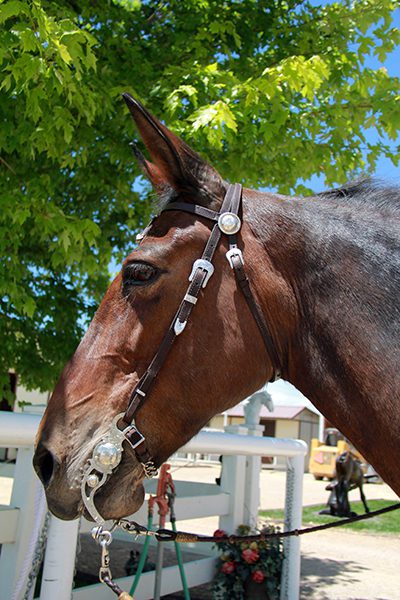 One very common behavioral problem that seems to identify the need for more leverage is the mule that bolts and runs when on the lead rope. This seems like an obvious disobedience to the handler, and the first thing that comes to mind is to use a lead shank with a chain to gain control of the mule. Normal use for a lead shank is during a Showmanship class at a show and it should rarely be used in training unless the equine will be shown at halter and/or showmanship. And then, training with the lead shank should be done only after the animal is following well through all required movements while in his halter and on a lead rope.
One very common behavioral problem that seems to identify the need for more leverage is the mule that bolts and runs when on the lead rope. This seems like an obvious disobedience to the handler, and the first thing that comes to mind is to use a lead shank with a chain to gain control of the mule. Normal use for a lead shank is during a Showmanship class at a show and it should rarely be used in training unless the equine will be shown at halter and/or showmanship. And then, training with the lead shank should be done only after the animal is following well through all required movements while in his halter and on a lead rope.
Chains are severe and when not used properly, can damage the fragile bones in the underside of the jaw, and the cartilage and bone over the nose of the equine. If the chain is pulled while simply run under the jaw and attached to the ring on the opposite side, a quick jerk can bear down hard into the delicate mandible (jawbone). If the chain is run over the nose, when abrupt pressure is applied it can injure the nasal cartilage or the incisive bones. Because they occur internally, these injuries are often imperceptible to the human eye. The only thing you might see is broken skin, scabs or bumps that arise from repeated use. When properly fitted, the chain on a lead shank goes through the ring of the halter on the left side, threads under the chin and through the ring on the right side of the noseband, and is attached at the throatlatch ring on the right side. This keeps the halter balanced and the action of the chain less severe. When using the lead shank for leverage during training, it can work on some animals but others may decide to fight which can result in injuries such as fractures, causing more severe trauma to these areas. So it is best to avoid use of the lead shank until after completing leading training with the halter and lead rope. Even then, you should learn to use the lead shank properly with the least amount of pressure possible. Avoid using halters that are made with chains. Those types of halters should only be used when showing cattle and can do serious damage to equines.
If, after you’ve employed a kind, considerate and respectful approach along with a food reward, your equine is still being uncooperative, it may be appropriate to use equipment with more leverage such as the “Quick Twist,” but not necessarily chains. Chains do need to be used in some cases, such as with work harness (and most curb bits are now fitted with chains), but when not used correctly, these chains can be abusive. The chains on the pleasure driving harness should clear the legs and heels of the driving equine, and the chin chain on a curb bit should be adjusted so that it is twisted properly and lies flat against the animal’s jaw with an allowance of two fingers between the chain and the jaw, thereby minimizing any chance of injury. If you have a generally compliant equine, it is better to use a leather chin strap on your curb bit rather than a chain.
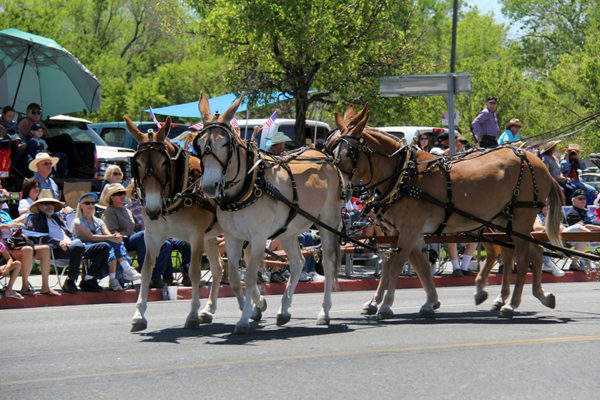 If, after you’ve employed a kind, considerate and respectful approach along with a food reward, your equine is still being uncooperative, it may be appropriate to use equipment with more leverage such as the “Quick Twist,” but not necessarily chains. Chains do need to be used in some cases, such as with work harness (and most curb bits are now fitted with chains), but when not used correctly, these chains can be abusive. The chains on the pleasure driving harness should clear the legs and heels of the driving equine, and the chin chain on a curb bit should be adjusted so that it is twisted properly and lies flat against the animal’s jaw with an allowance of two fingers between the chain and the jaw, thereby minimizing any chance of injury. If you have a generally compliant equine, it is better to use a leather chin strap on your curb bit rather than a chain.
If, after you’ve employed a kind, considerate and respectful approach along with a food reward, your equine is still being uncooperative, it may be appropriate to use equipment with more leverage such as the “Quick Twist,” but not necessarily chains. Chains do need to be used in some cases, such as with work harness (and most curb bits are now fitted with chains), but when not used correctly, these chains can be abusive. The chains on the pleasure driving harness should clear the legs and heels of the driving equine, and the chin chain on a curb bit should be adjusted so that it is twisted properly and lies flat against the animal’s jaw with an allowance of two fingers between the chain and the jaw, thereby minimizing any chance of injury. If you have a generally compliant equine, it is better to use a leather chin strap on your curb bit rather than a chain.
If you train for leading with a step-by-step program that incorporates a reward system during training, the mule is much less likely to bolt and pull the lead rope from your hands, and horses will not need any more leverage at all. This kind of training invites the equine to remain with you and he is rewarded lavishly when he does. If a horse spooks, you can usually stand still in balance, hang onto the lead rope and quickly regain his attention by staying calm and deliberate yourself.
Normally, mules learn to comply with the reward training. However, if a mule has been spooked, he may not care much about the reward in your fanny pack and you might have the need to use something with more leverage. In this case and in cases where a mule doesn’t always comply willingly, I use a new positioning of the lead rope called a “Quick Twist.”
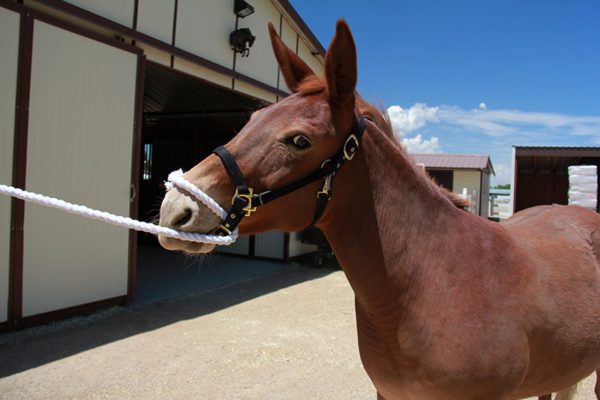 To employ the “Quick Twist” restraint, just take your lead rope and create a loop and feed it through the noseband of your nylon halter (rope halters are too loose and do not work) from back to front and then over the mule’s nose. When you pull on the rope, it will tighten around the end of the his nose below the incisive bones and over the cartilage, making breathing just a little difficult. Don’t keep pulling—just stand quietly and hold the tension snug. Let the equine come forward to you and slacken the rope himself by coming forward and allowing a free flow of air through his nostrils. Then, if the mule does not follow, just walk a step or two, creating tension on the rope, and then stand still again. When he does come forward, stop long enough to reward him with the oats reward before you proceed forward again. Keep the lead rope short and stand still in a balanced way so he cannot get ahead of you and jerk you off your feet. If you are standing still in a balanced position, it will be difficult for him to jerk the lead rope from your hand and leave.
To employ the “Quick Twist” restraint, just take your lead rope and create a loop and feed it through the noseband of your nylon halter (rope halters are too loose and do not work) from back to front and then over the mule’s nose. When you pull on the rope, it will tighten around the end of the his nose below the incisive bones and over the cartilage, making breathing just a little difficult. Don’t keep pulling—just stand quietly and hold the tension snug. Let the equine come forward to you and slacken the rope himself by coming forward and allowing a free flow of air through his nostrils. Then, if the mule does not follow, just walk a step or two, creating tension on the rope, and then stand still again. When he does come forward, stop long enough to reward him with the oats reward before you proceed forward again. Keep the lead rope short and stand still in a balanced way so he cannot get ahead of you and jerk you off your feet. If you are standing still in a balanced position, it will be difficult for him to jerk the lead rope from your hand and leave.
Old-time twitches were made with a chain that could be twisted around the upper lip and used to distract the equine from shots, tube worming and the like, but the main focal point for the equine then becomes the equipment and not the task and, in the wrong hands, this piece of equipment can do a lot of damage to the equine’s sensitive upper lip. Most often, the equine can be more easily distracted by a simple rap on his forehead using your knuckles. Using a twitch at all can become a source of confrontation for many equines. If a twitch must be used, choose a more humane one that is made from aluminum and has a smooth surface. This will clamp down tight enough to hold, but not so tightly on the upper lip that it causes pain or even injury.
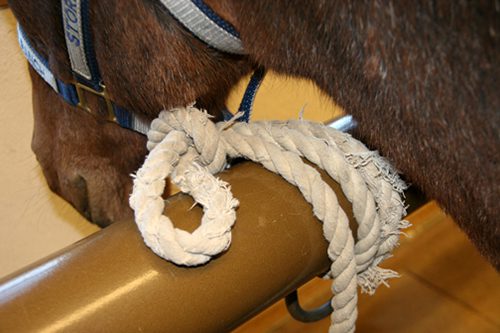 Restraints should not be used as a means to control your animal except for a short period of time with the purpose of showing them a correct behavior. Restraints should be used as a support and not a controlling device. Restraints should be “phased out” as soon as possible.
Restraints should not be used as a means to control your animal except for a short period of time with the purpose of showing them a correct behavior. Restraints should be used as a support and not a controlling device. Restraints should be “phased out” as soon as possible.
I call this next restraint method the “Face Tie.” For the sake of safety, tie your mule to a good stout hitch rail. Then use our Face Tie technique (TMD DVD #2), running the lead rope around the hitch rail (or fence) and back through the noseband of the halter (nylon halters work best for this). Then come around a second time and loop it through the throatlatch part of the halter and around the hitch rail once more and tie it off. Take up the slack slowly as he gives and be ready to reward him with oats when he complies, then keep taking up the slack until his face is against the fence or hitch rail.
 Do not try to bully him into it or he will just pull back. This should be done while he is standing parallel to the hitch rail so that when you pull the rope tight, it pulls his head tightly sideways to the hitch rail. This will keep him from being able to swing his rear end around to block you. Reward him with oats and let him quiet down in this restraint before approaching with your shot. If he manages to keep you off the clear side, you can always go to the other side of the hitch rail and give him the shot from that side without fear of injury. You can do this along a stout fence provided the rails are sturdy. If you do this correctly, it will simply restrain him in a safe manner and keep you out of the line of fire. Each new time that you give shots, try to do it with the rope a little looser each time to fade out the restraint. They will usually just come to expect and go for their position along the hitch rail or fence and will lean into it like they do when you first gave the shots like this. He will soon learn to quiet down immediately when his face is being tied and at best will seem to be saying, “Dang, do we have to do this again?!” But, he will learn to comply.
Do not try to bully him into it or he will just pull back. This should be done while he is standing parallel to the hitch rail so that when you pull the rope tight, it pulls his head tightly sideways to the hitch rail. This will keep him from being able to swing his rear end around to block you. Reward him with oats and let him quiet down in this restraint before approaching with your shot. If he manages to keep you off the clear side, you can always go to the other side of the hitch rail and give him the shot from that side without fear of injury. You can do this along a stout fence provided the rails are sturdy. If you do this correctly, it will simply restrain him in a safe manner and keep you out of the line of fire. Each new time that you give shots, try to do it with the rope a little looser each time to fade out the restraint. They will usually just come to expect and go for their position along the hitch rail or fence and will lean into it like they do when you first gave the shots like this. He will soon learn to quiet down immediately when his face is being tied and at best will seem to be saying, “Dang, do we have to do this again?!” But, he will learn to comply.
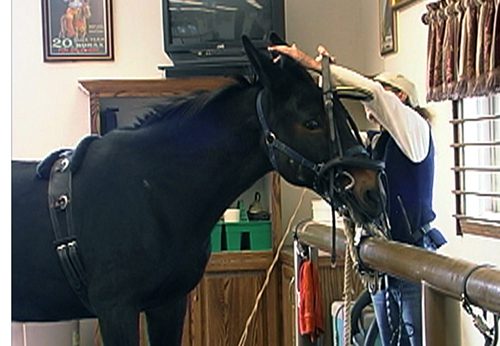 This is a humane restraint for mules and donkeys, but do not try this with a horse! This is a good restraint to use (and fade out) for any Longears that is difficult to worm, give shots, take blood, clip bridle paths and to use for those that are difficult to bridle. When using the Face Tie for bridling training (or clipping the bridle path), you will only need to go through the noseband and hitch rail (and not through the throatlatch unless you need to prevent them from turning into you). Just make sure when you put on the bridle that you “protect” their sensitive ears with your hands as it goes on and they will learn to trust you. Put the bridle on over the halter for the lessons until they don’t mind the bridling process.
This is a humane restraint for mules and donkeys, but do not try this with a horse! This is a good restraint to use (and fade out) for any Longears that is difficult to worm, give shots, take blood, clip bridle paths and to use for those that are difficult to bridle. When using the Face Tie for bridling training (or clipping the bridle path), you will only need to go through the noseband and hitch rail (and not through the throatlatch unless you need to prevent them from turning into you). Just make sure when you put on the bridle that you “protect” their sensitive ears with your hands as it goes on and they will learn to trust you. Put the bridle on over the halter for the lessons until they don’t mind the bridling process.
If they lean away from you, you can just pull on the halter to bring the head back to you to finish bridling. Each time you use the “Face Tie” method,” see if you can leave it looser each time until they just stand for putting on the bridle while it is at its loosest. Then you will no longer have to use it.
Keep your lessons short, only 20-40 minutes (depending on how compliant they are) every other day and never two days in a row. They need a day off to ponder what they have learned and when they are allowed this break between lessons, they will come back the next time and do the tasks more easily. They usually leave because they perceive the lesson to be either too long or too difficult (and they would rather play!).
It is always better to not use the Scotch Hobble if you do not need to do it. If your donkey will pick up his feet for you, just give him the opportunity to “meet” your farrier by having him give him a handful of oats. Then see if he will yield his feet. If not, then you go ahead and pick up his foot with the farrier standing beside you, give him the reward for picking up his foot and then hand it off to the farrier while you back up and continue to feed him small handfuls of oats for compliance. Eventually, you should be able to step away and just have a bucket of oats in front of him to eat while the farrier is working on him (and take it away if he won’t comply). If he has a friend, it is always best to do donkeys in groups. They stay calmer that way. Try this FIRST!
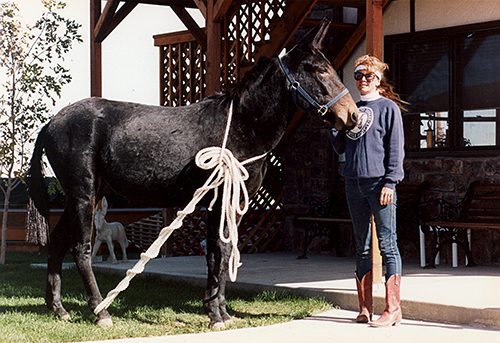 Your Longears will only need the kicking training covered in DVD #2 (Simple touch training with a driving whip) if he is resistant to having his hind legs worked with and even then, you should try picking them up with the scotch hobble rigging first. If he kicks with that, just hold the rope taut until he quits. Then, hold the foot off the ground for a couple of seconds and release it where the foot will touch the ground again. He just needs to know that when you pick up the hind foot, you will return it to him if he is good. During all of this, be sure to reward when he is standing still. If he complies easily about picking up his feet easily after trying to pick them up with the rope, you may not need to use the Scotch Hobble in it’s ultimate constraining position.
Your Longears will only need the kicking training covered in DVD #2 (Simple touch training with a driving whip) if he is resistant to having his hind legs worked with and even then, you should try picking them up with the scotch hobble rigging first. If he kicks with that, just hold the rope taut until he quits. Then, hold the foot off the ground for a couple of seconds and release it where the foot will touch the ground again. He just needs to know that when you pick up the hind foot, you will return it to him if he is good. During all of this, be sure to reward when he is standing still. If he complies easily about picking up his feet easily after trying to pick them up with the rope, you may not need to use the Scotch Hobble in it’s ultimate constraining position.
To employ the Scotch Hobble in its entirety, tie a Bowline knot loosely around the neck. Depending upon the size of the animal, the rope should be 16’-22’ long. Take the excess rope down to the pastern of the hind foot, loop it around the pastern, then back up through the loop around the neck, then back round the pastern a second time. Last, loop the rope around the ropes going from the pastern to the neck to capture them and tie off with a safety knot at the neck loop.
Only tie the Scotch hobble as tightly as is needed, and it is best to leave the toe touching the floor for balance. In some cases, you may have to tie the hind legs higher to prevent kicking on the off side, but be prepared to loosen the rope when the animal stops struggling with his balance. Remember that they can tire and not be able to continue to stand for long periods of time.
When taking the first wrap on the pastern of the hind leg, take the end of the rope well behind him and encourage him to step over it, keeping yourself out of kicking range. Then bring the rope along his side to the front and slip it through the loop around his neck. If he won’t let you go through the loop around his neck, you can just hold the rope taut around his pastern without putting it through the loop first and just allow him to settle before putting it through the loop. Just be very patient. When you get to this point, many animals will begin to kick. Just stand to the side, out of biting and kicking range, and keep the rope taut. Just hang onto it with both hands and stand quietly until he stops struggling. Allow your hands to follow a pull and release with the motion of his leg. If you allow your hands to move forward and back with the pulling of the rope and keep it taut, it won’t come off the pastern. Don’t try to hold his foot stationary at this point. You can easily step out of his way from this distance and position.
When he stops struggling, keep the rope the same tautness, walk to his head and give him a reward for standing still. Pet him and then proceed to go behind him again and take the second loop. Again, stand to the side if he begins to kick and wait for him to stop, allowing your hands to move back and forth with his kicking leg, maintaining the tautness in the rope. This is a give and release action that should not make him as mad as trying to hold the rope tight. Again, when he stops struggling, he is entitled to a reward.
If you do it this way, slowly and in small steps, you will not aggravate him as much and he will be more likely to comply. If you have been patient and meticulous while doing this procedure, tying the last knot around the neck rope should not be a problem, and you will not run the risk of him escaping from it.
Use a soft cotton twisted rope of the correct length measured to your animal for ease and to avoid chafing for the best results. It need not be traumatic if you proceed this way. Use the Scotch Hobble as needed, but each time, tie it as loosely as you are able and still have him stand still. For example, if you have had to raise the toe, don’t raise the toe and let it touch the floor. Next time, have the toe touch the floor with the ropes loosely tied. Next, take only one loop around the pastern, keep the rope fairly loose and tie to the rope around the neck. Lastly, just take the rope to 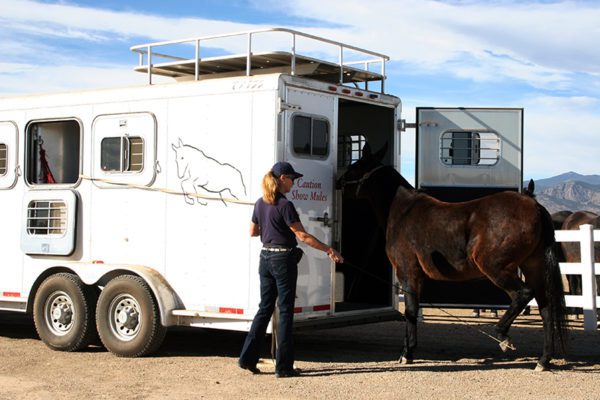 the hind foot, around the pastern and let it lay on the floor. Next time, you won’t have to use it at all. Your goal is to phase out the restraint entirely.
the hind foot, around the pastern and let it lay on the floor. Next time, you won’t have to use it at all. Your goal is to phase out the restraint entirely.
A lot of activity when trailer loading can cause the equine to become anxious and noncompliant and he becomes overstimulated. When having difficulty loading your equine, things will usually go better if you simply give him time to survey the situation.
Do not allow him to back away from the trailer. One step at a time while offering a food reward (and a food reward waiting inside the trailer), with frequent pauses and encouragement to move forward from behind with a tap of the whip, will usually accomplish the task without confrontation. Most equines will willingly follow you right into the trailer if prior obstacle training has been done properly and successfully. Leverage equipment such as butt ropes only refocus the equine’s attention on the equipment and will result in a confrontation.
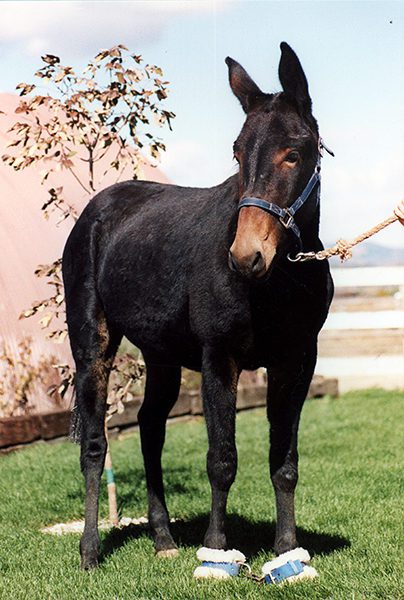 Hobbles are another form of leverage equipment and there are many different kinds of hobbles for different purposes. The hobbles that have chains on them should be avoided, as the equine can become entangled and the chains can do damage to their legs. Thin leather hobbles or coarse rope can chafe the hair right off the skin around the pastern and can cause severe abrasions that may never heal. Thick leather hobbles are best, as they will break when under extreme stress, releasing before damage to the equine is done. If so inclined, all mules and some horses can gallop in hobbles, so hobbles really aren’t all that effective for leverage. Tying onto a hyline (a rope suspended high between two trees that acts as a hitching line for overnighting equines in the mountains) is a better choice, and if the horses are tied, then the mules should not have to be tied or hobbled because they will generally stay with the horses. Personally, I only use hobbles in a controlled situation at the work station when body clipping my equine’s legs for show.
Hobbles are another form of leverage equipment and there are many different kinds of hobbles for different purposes. The hobbles that have chains on them should be avoided, as the equine can become entangled and the chains can do damage to their legs. Thin leather hobbles or coarse rope can chafe the hair right off the skin around the pastern and can cause severe abrasions that may never heal. Thick leather hobbles are best, as they will break when under extreme stress, releasing before damage to the equine is done. If so inclined, all mules and some horses can gallop in hobbles, so hobbles really aren’t all that effective for leverage. Tying onto a hyline (a rope suspended high between two trees that acts as a hitching line for overnighting equines in the mountains) is a better choice, and if the horses are tied, then the mules should not have to be tied or hobbled because they will generally stay with the horses. Personally, I only use hobbles in a controlled situation at the work station when body clipping my equine’s legs for show.
Sedation and tranquilizers are another form of leverage that is used all too often and, in some cases, can be very dangerous. Mules and donkeys may receive the correct dose, but they can be unaffected when they get over-stimulated, excited and confrontational. They can actually “pop out” of sedation if they get excited enough to release adrenaline in their bodies. In these cases, administering another dose of drugs can easily become an overdose and could result in death. Sedating an equine that is to be trimmed or shod can be dangerous for both the farrier and the equine because the animal is not able to stabilize his balance and his reactions are, for the most part, uncontrolled. The farrier may not have time to get out of the way and the animal could stumble into trouble.
Power tools can be of help to a veterinarian or an equine dentist when doing teeth. Old-fashioned rasps are safer than power tools, but they are clearly more of an aggravation to the equine. However, if power tools are to be used at all, they must be carefully monitored. When floating teeth, the equine dentist must be skilled in the use of his grinding tool and should do only what is necessary to remove sharp points on the equine’s teeth. Power tools can be a good thing when you are dealing with an equine’s mouth and jaw, as having their mouths held open for long periods of time is very tiring for them, so speed is essential, but accuracy and skill are also essential.
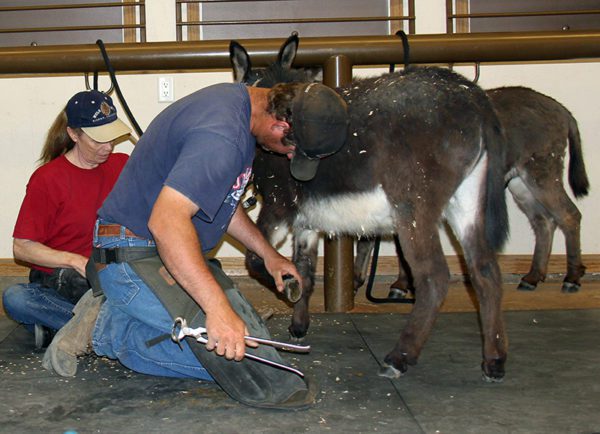 I do not approve of using power tools on the equine’s hooves at all. In order for the equine’s body to be properly balanced in good posture, the hooves must first be properly balanced. Power tools cannot possibly shape the hoof with proper curvature in the sole, alignment of angles and equal balance over the hoof walls with appropriate pressure to the heels and frog.
I do not approve of using power tools on the equine’s hooves at all. In order for the equine’s body to be properly balanced in good posture, the hooves must first be properly balanced. Power tools cannot possibly shape the hoof with proper curvature in the sole, alignment of angles and equal balance over the hoof walls with appropriate pressure to the heels and frog.
This demands hands-on custom sculpting, as each foot on each equine will be different and all four feet need to be aligned with each individual’s legs and body in mind. The hooves are the basic foundation for the entire body, so they must be done correctly or everything else will be off. This is especially true with the tiny hooves of mini donkeys and mules. Minis can often be kept calm for trims simply by keeping things at their eye level and rewarding their good behavior with crimped oats.
There are things that may seem to allow for shortcuts through certain tasks, but when you are dealing with living creatures there really are no shortcuts. It is always better to take the necessary time to implement training techniques that allow your equine to learn and grow in a logical, step-by-step process that will not overwhelm him or bombard him with too much stimulus at any stage, so that he can become a comfortable and cooperative individual. If you use the correct methods right from the beginning, the need for excessive retraints (that can cause pain and even more resistance) will be greatly diminished and the long-term results will be undeniably better.
To learn more about Meredith Hodges and her comprehensive all-breed equine training program, visit LuckyThreeRanch.com, MEREDITH HODGES PUBLIC FIGURE Facebook page, or call 1-800-816-7566. Check out her children’s website at JasperTheMule.com. Also, find Meredith on Pinterest, Instagram, MeWe, YouTube and Twitter.
Covered in TRAINING MULES & DONKEY: A LOGICAL APPROACH TO TRAINING, TRAINING WITHOUT RESISTANCE, TRAINING DVD #2 and EQUUS REVISITED at www.luckythreeranchstore.com
© 2013, 2016, 2024 Lucky Three Ranch, Inc. All Rights Reserved.
View all Mule Crossing articles
MULE CROSSING: Suitability of Donkeys and Mules For Children
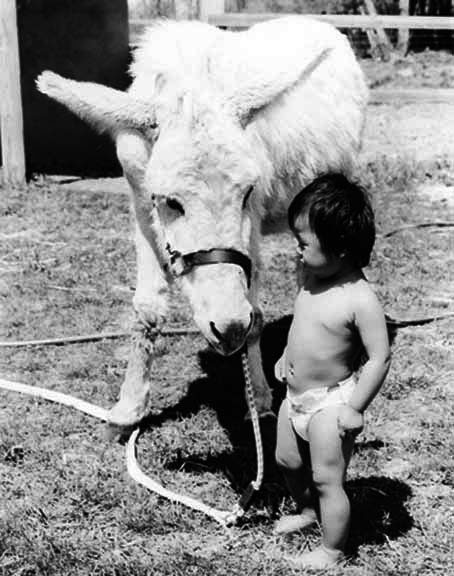 By Meredith Hodges
By Meredith Hodges
Many have inquired as to the suitability of mules and donkeys for children. As with any equine, choosing the right individual for your child is of primary importance. However, as a general rule, we find that donkeys make excellent mounts for beginning riders because of their patient, quiet nature and good common sense. They can be the best possible babysitter. There are things to consider when choosing a donkey for your child:
The first rule to observe is never get a donkey jack for your child! Though he may be sweet and docile by nature, he is still governed by strong natural instincts so his character is not consistent. He is a stud and must be treated as such.
Donkey jennets are good prospects for children provided they are not in heat or in foal. When a jennet is in heat she may become cross and if she is in foal, or has one at her side, she is also governed by instinct for the protection and welfare of her offspring.
The best possible mount for a child is a donkey gelding. He possesses all the positive traits of the donkey without being subject to primitive instincts. Since most donkeys are small in size and possess an affectionate attitude, they make excellent companions as well as mounts for children.
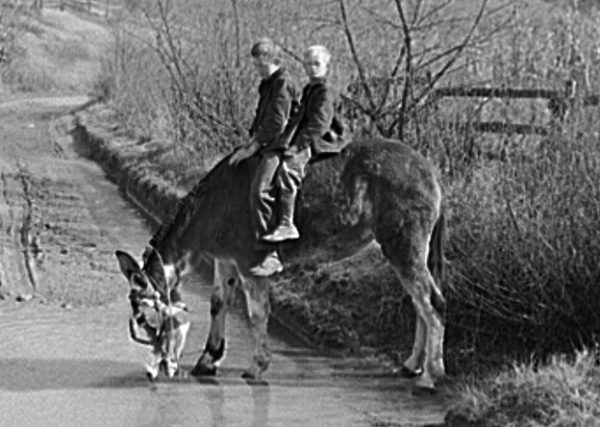 Since a donkey can became quite stubborn when treated badly, it is important that you take the time to help your child and donkey get started properly. Even an untried donkey with proper help can be a wonderful mount for a child. In the first few weeks, the child and donkey should simply spend time getting to know one another. Teach your child the correct way to handle and groom the donkey. The personal bond between them will develop on its own.
Since a donkey can became quite stubborn when treated badly, it is important that you take the time to help your child and donkey get started properly. Even an untried donkey with proper help can be a wonderful mount for a child. In the first few weeks, the child and donkey should simply spend time getting to know one another. Teach your child the correct way to handle and groom the donkey. The personal bond between them will develop on its own.
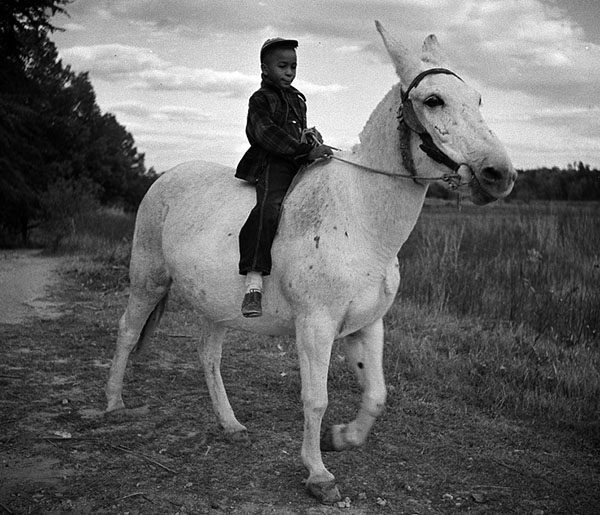 When your child and donkey have developed confidence in each other, you can begin to teach them the fundamentals of riding. Tack up the donkey in a small saddle and snaffle bridle and take him into a small pen on the lunge line. Allow your child to sit astride the donkey as he walks around you. Explain to your child the basics of turning and stopping with a direct rein, commonly called plow reining. Be sure to instruct the child not to pull hard or jerk the reins. Donkeys have very sensitive mouths and do not respond correctly when they are in pain.
When your child and donkey have developed confidence in each other, you can begin to teach them the fundamentals of riding. Tack up the donkey in a small saddle and snaffle bridle and take him into a small pen on the lunge line. Allow your child to sit astride the donkey as he walks around you. Explain to your child the basics of turning and stopping with a direct rein, commonly called plow reining. Be sure to instruct the child not to pull hard or jerk the reins. Donkeys have very sensitive mouths and do not respond correctly when they are in pain.
Teach your child to use verbal commands in conjunction with the reins and leg cues. When he wants to go forward for instance, tell your child to ask the donkey to walk. Tell the child to squeeze with his legs – don’t just kick. He should get the desired response. If the child wishes to turn, tell him to ask the donkey to “Haw” (left) or “Gee” (right). Instruct the child to pull gently on the direct rein and push the donkey into the turn with the opposite leg. When stopping, tell the child to first say “Whoa,” and then pull gently on the reins and sit deeper in the saddle to initiate the stop. When the donkey complies with the commands given, do not be afraid to reward him. He will be more than willing to perform the next time you ask him.
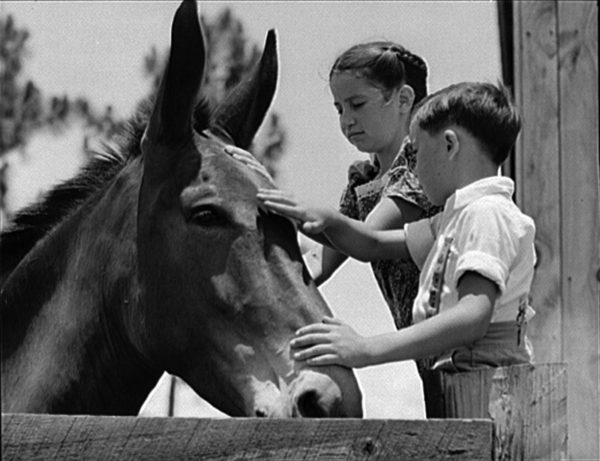 Love and caresses are an excellent reward and a reward of crimped oats certainly does no harm. Donkeys are very appreciative animals. If the child and donkey are supervised correctly, it can greatly enhance the entire riding experience. The donkey will protect your child with his excellent judgment and the child will learn to be a patient and understanding person through interaction with his donkey. The reason is simple; donkeys will not respond unless treated fairly. Many an equestrian in Great Britain has spent his early years astride a donkey and have become better riders because of it! So if your child expresses an interest in riding, consider starting with a donkey gelding, or maybe even a jennet. Besides being patient with children, his size is more suitable, he has ample strength to carry them and is an easy keeper so feed and vet bills can usually be kept at a minimum.
Love and caresses are an excellent reward and a reward of crimped oats certainly does no harm. Donkeys are very appreciative animals. If the child and donkey are supervised correctly, it can greatly enhance the entire riding experience. The donkey will protect your child with his excellent judgment and the child will learn to be a patient and understanding person through interaction with his donkey. The reason is simple; donkeys will not respond unless treated fairly. Many an equestrian in Great Britain has spent his early years astride a donkey and have become better riders because of it! So if your child expresses an interest in riding, consider starting with a donkey gelding, or maybe even a jennet. Besides being patient with children, his size is more suitable, he has ample strength to carry them and is an easy keeper so feed and vet bills can usually be kept at a minimum.
What of the suitability of a mule for child? As the mule is half donkey, he possesses many of the fine 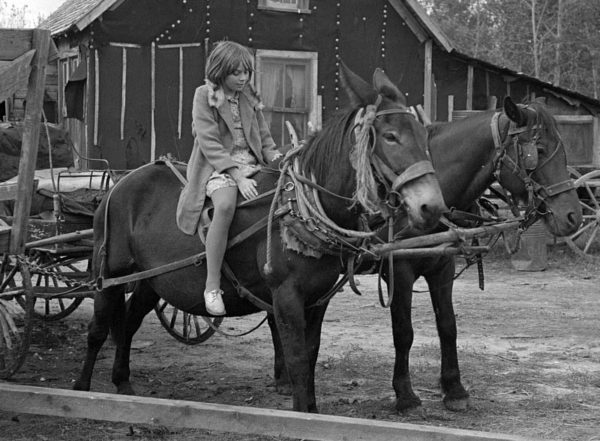 characteristics that make him suitable for children. But at this point I must caution you that he is also part horse and will generally get his disposition from the mare. So if you wish to get a mule for your child, be sure he is an individual with a quiet disposition. Then you can consider such things as size, color and other traits. The right mule can be just as good a babysitter as the right donkey, and usually more reliable than any horse!
characteristics that make him suitable for children. But at this point I must caution you that he is also part horse and will generally get his disposition from the mare. So if you wish to get a mule for your child, be sure he is an individual with a quiet disposition. Then you can consider such things as size, color and other traits. The right mule can be just as good a babysitter as the right donkey, and usually more reliable than any horse!
Children and donkeys or mules, have not been seen together much in this country in the more recent past. Perhaps it is because we have not given children a chance to show their Longears publicly. Realizing this need, as in horse shows, youth classes have been included in the Longears shows of today to encourage our youth to take an active interest in the promotion of Longears. The jobs these “kids” are doing with their mules and donkeys are marvelous and their contributions are extensive. The values learned by children when dealing with donkeys and mules will stand them in good stead throughout their lives, not to mention the joy they will discover in having such a companion. So during this season of giving, consider making Longears a part of your life and give a homeless donkey, burro or mule a chance. Your child will welcome this affectionate and sensible companion. If you adhere to the guidelines I have given to you, you should not be disappointed.
To learn more about Meredith Hodges and her comprehensive all-breed equine training program, visit LuckyThreeRanch.com, MEREDITH HODGES PUBLIC FIGURE Facebook page, or call 1-800-816-7566. Check out her children’s website at JasperTheMule.com. Also, find Meredith on Pinterest, Instagram, MeWe, YouTube and Twitter.
© 1985, 2016, 2018, 2021, 2024 Lucky Three Ranch, Inc. All Rights Reserved.
MULE CROSSING: Driving Activities
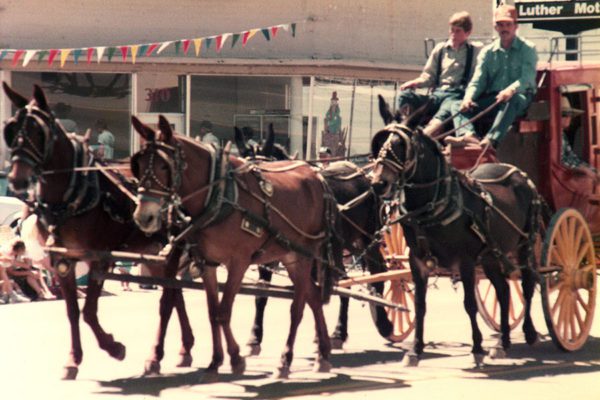 By Meredith Hodges
By Meredith Hodges
With the introduction of the automobile came decreased interest in horse-drawn vehicles. Tractors replaced equine-driven vehicles in the fields. It seemed as if equines had been put out of a job! But, as with any change, this was only temporary. Modern society still has need of equine participation, especially from donkeys and mules. The well-schooled driving donkey or mule is much safer and more reliable than any horse. The reason for this is the donkey and mules’ natural sensibility and their positive response to verbal communication. Once they have learned the parameters of their job, if treated fairly, they will calmly and diligently go about their business, flicking their ears back and forth toward the driver, always listening for verbal reinforcement of their behavior. In a pinch, they can more often be prevented from “freaking out” with a few calm and reassuring words. Their strength and durability enables them to work longer and harder hours than can a horse and their variety of sizes and colors provides them as suitable driving animals for a number of driving-related activities.
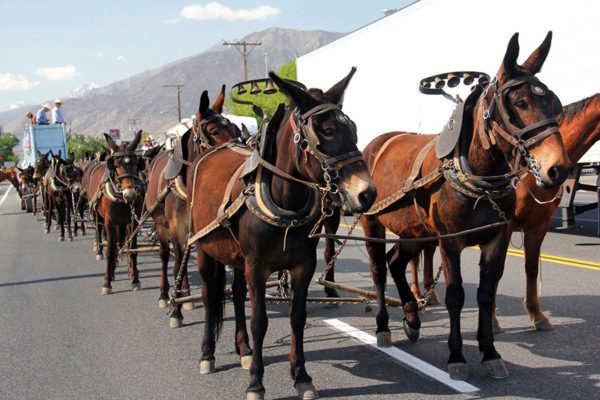 Most often we see driving animals in parades. Although it seems simple enough to drive down a parade route, there are a number of things to consider that can complicate the issue. Parade routes are lined with potential hazards and an overload of outside stimuli. Horses that become spooked have been known to bolt and actually run right through crowds of people. I have yet to hear of a donkey or mule that has done such a thing! Perhaps it is because the donkey or mule will not run into trouble if he can possibly avoid it. He will also be more likely to rely upon his driver for support and direction through the safest route. He will stop if in doubt of a situation when properly trained. Mules and donkeys are familiar with teamwork and will work as a team with their driver. The frightened horse just says, “Forget you!” and leaves!
Most often we see driving animals in parades. Although it seems simple enough to drive down a parade route, there are a number of things to consider that can complicate the issue. Parade routes are lined with potential hazards and an overload of outside stimuli. Horses that become spooked have been known to bolt and actually run right through crowds of people. I have yet to hear of a donkey or mule that has done such a thing! Perhaps it is because the donkey or mule will not run into trouble if he can possibly avoid it. He will also be more likely to rely upon his driver for support and direction through the safest route. He will stop if in doubt of a situation when properly trained. Mules and donkeys are familiar with teamwork and will work as a team with their driver. The frightened horse just says, “Forget you!” and leaves!
Driving competitions are becoming more popular than ever these days as a number of different types of driving classes are being made available to contestants. For the really serious competitor, there are pleasure, obstacle, and Reinsmanship classes in which to measure one’s progress in performance.
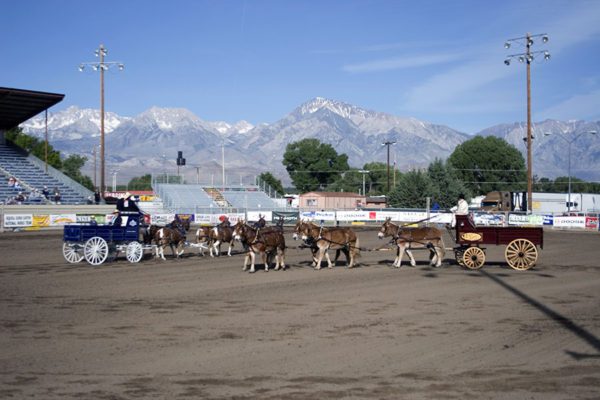 As the competitor improves, he may move into marathon driving, testing his skills across country and through obstacles (called hazards). The driver may use singles, or teams, depending on his personal preference. The American Driving Society has been more than generous, allowing mules and donkeys to compete in most of their events right along with the horses. For more fun-loving competitors, there are a lot of different driving games, gauged for the ability of the competitors. This allows even the most inexperienced driver some source of enjoyment from which he can derive a sense of accomplishment and excitement.
As the competitor improves, he may move into marathon driving, testing his skills across country and through obstacles (called hazards). The driver may use singles, or teams, depending on his personal preference. The American Driving Society has been more than generous, allowing mules and donkeys to compete in most of their events right along with the horses. For more fun-loving competitors, there are a lot of different driving games, gauged for the ability of the competitors. This allows even the most inexperienced driver some source of enjoyment from which he can derive a sense of accomplishment and excitement.
For those who want to enjoy a nice day in the country with their animals, there are rallies and organized picnic drives. This type of driving is more relaxing, but no less rewarding and satisfying than competitive events. Awards are sometimes given at rallies for coming in closest to the optimum time, but the pace is usually quite leisurely! Your donkey or mule will love the alternative to showing and will enjoy the activities as much as you do.
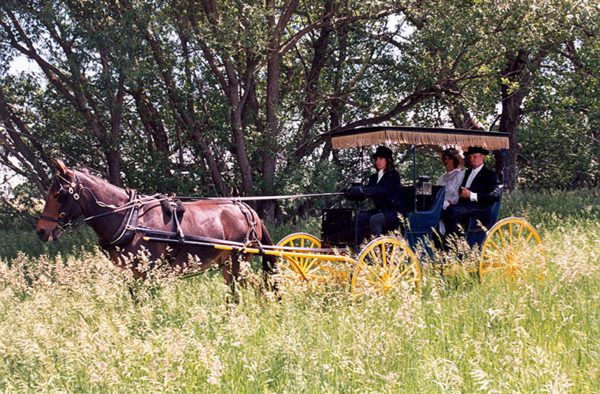 Mules and donkeys are used in many tourist areas, pulling cabs and carriages of all varieties, taking tourists in a more leisurely fashion through the streets of history and tradition. Couples can romantically celebrate special moments in their relationships with a relaxing ride in a special cab or buggy. The sensible mule or donkey assures a safe and romantic memory that will stay with you for the rest of your life! We have used our mules to pull carriages for weddings and receptions, adding a touch of class and a little tradition to an otherwise fast-paced and chaotic world!
Mules and donkeys are used in many tourist areas, pulling cabs and carriages of all varieties, taking tourists in a more leisurely fashion through the streets of history and tradition. Couples can romantically celebrate special moments in their relationships with a relaxing ride in a special cab or buggy. The sensible mule or donkey assures a safe and romantic memory that will stay with you for the rest of your life! We have used our mules to pull carriages for weddings and receptions, adding a touch of class and a little tradition to an otherwise fast-paced and chaotic world!
Because of their thoughtful and affectionate nature, donkeys and mules are ideal candidates for handicapped and disabled drive and ride programs. They are not as abruptly spooked as horses, and are therefore less likely to unseat a disabled rider, or run off with a disabled driver. Horses have fared reasonably well in riding programs for the disabled and handicapped, but are not really reliable enough for driving programs of this kind. This is where Longears can excel! Mule and donkey drive and ride programs, such as the Slade Centre at the Donkey Sanctuary in Great Britain, afford disabled and handicapped people the opportunity to enjoy the wonders of nature by offering them more mobility with the assistance of a new “friend” who is gentle and affectionate. These “friends” replace hopelessness with joy and fulfillment, helping to make life worth living!
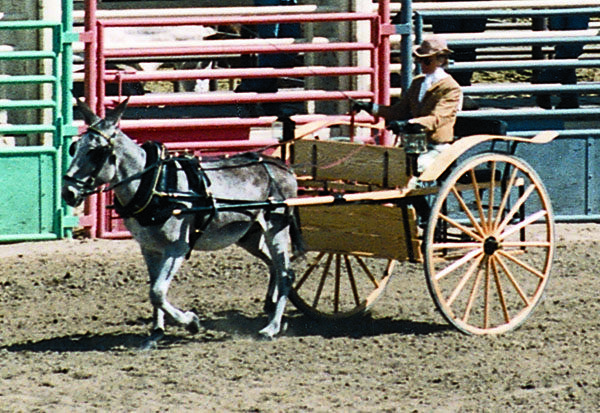
Driving itself is a wonderful recreation for just about anyone, from the smallest child to the eldest grandmother. Driving donkeys or mules gives you that extra sense of security in an otherwise potentially dangerous situation. Driving a donkey or mule can provide a companion and friend to otherwise lonely and unfulfilled persons, keeping life more positive and enjoyable. Riding equines for enjoyment still requires a certain amount of training and practice. Learning to drive requires a lot less training and practice time for the driver, provided that the animal is well-schooled and obedient. Small farms today still use mules and donkeys for farm work. When they know their job, they do it with ease and sometimes work exclusively on verbal communication. Old farmers speak of their mules with pride and affection. It’s nice to have a “hand” that doesn’t talk back and isn’t afraid of a little hard work! In this fast-paced world, sometimes it’s nice to go a little slower and take in all the beautiful and fulfilling things that life has to offer, like a relaxing drive in the country with your very best friend!
To learn more about Meredith Hodges and her comprehensive all-breed equine training program, visit LuckyThreeRanch.com, MEREDITH HODGES PUBLIC FIGURE Facebook page, or call 1-800-816-7566. Check out her children’s website at JasperTheMule.com. Also, find Meredith on Pinterest, Instagram, MeWe, YouTube and Twitter.
© 1992, 2016, 2018, 2022, 2024 Lucky Three Ranch, Inc. All Rights Reserved.
